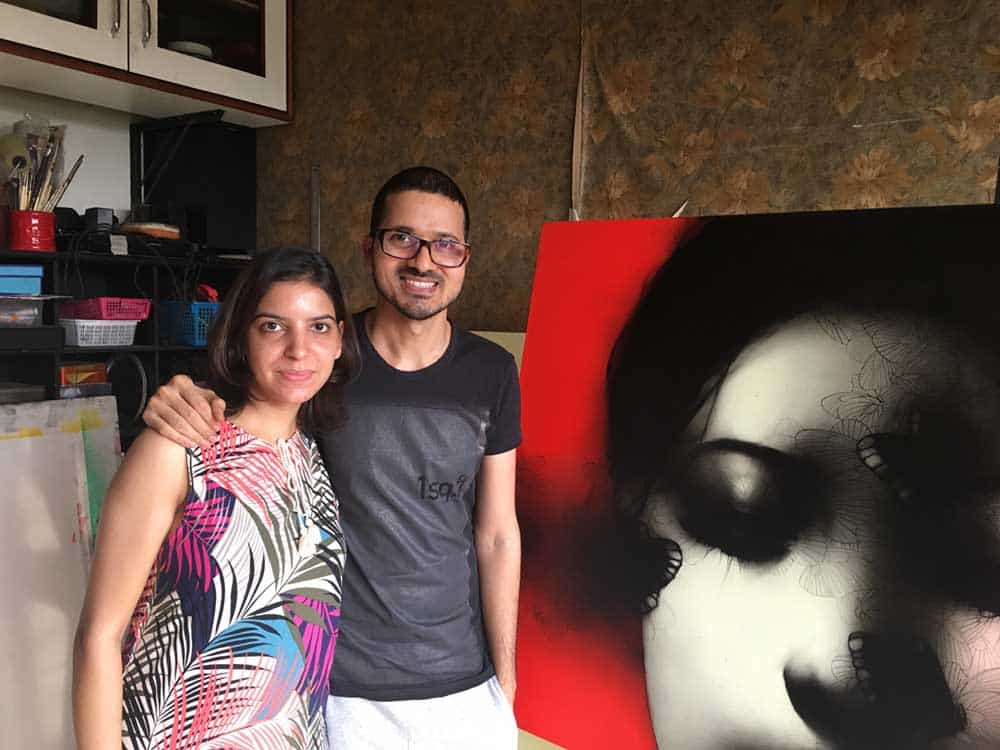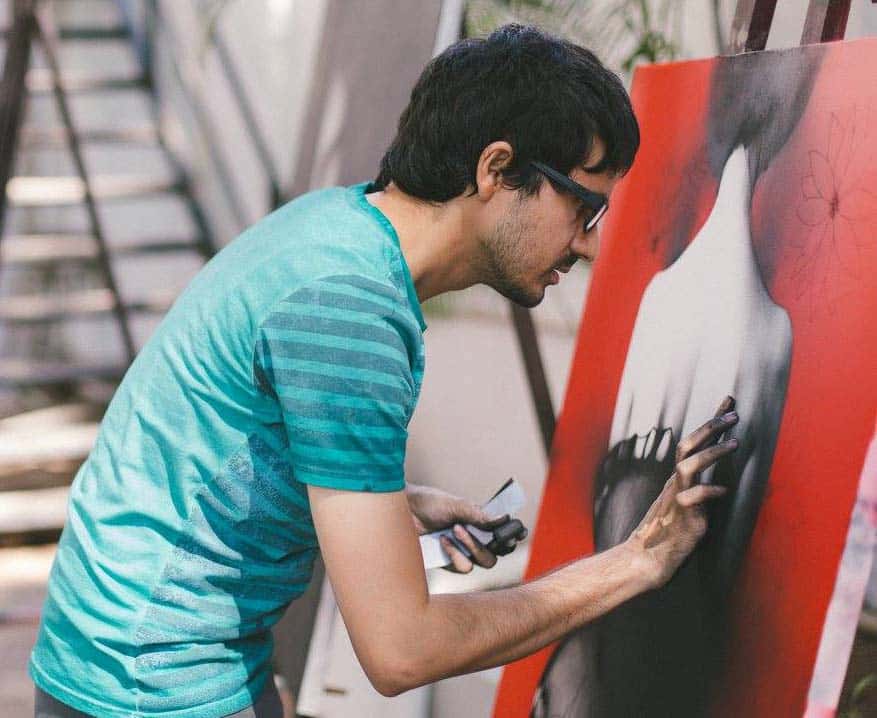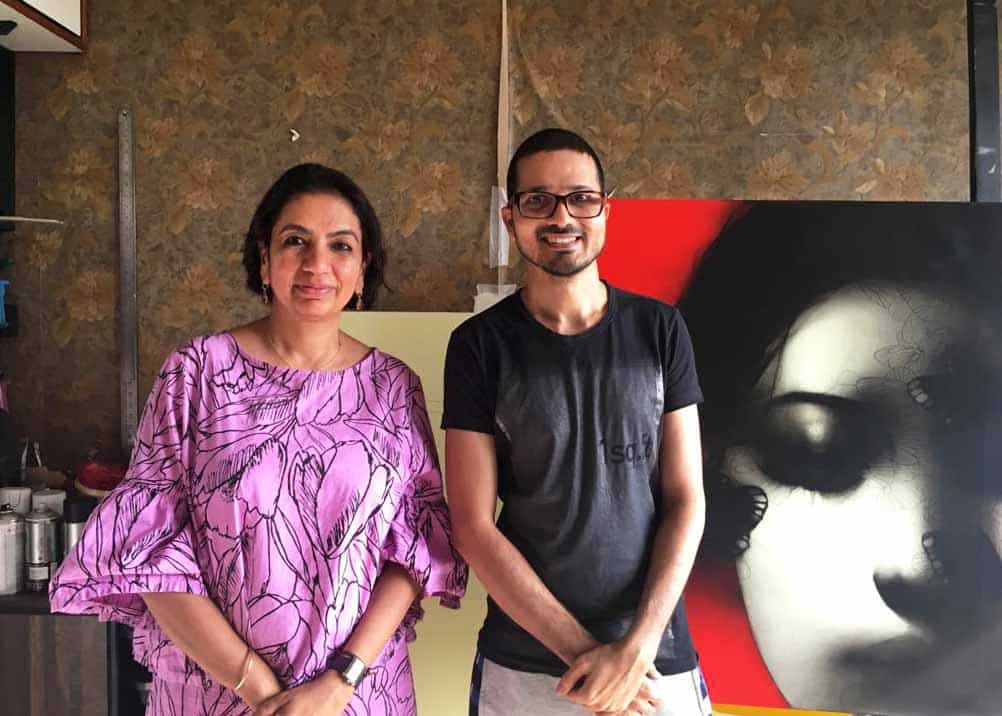
INTERVIEW WITH CONTEMPORARY INDIAN ARTIST NISHANT DANGE
The breathtaking paintings of contemporary Indian artist Nishant Dange are studies in fragility — the wisps of hair and delicate eyelashes of women, and the lacy wings of butterflies — but also in strength. Both women and butterflies undergo many difficult transformations in their lives, yet they maintain their inner and outer beauty. Sensual, innocent, bold and striking all at once, the women on his canvases are simply captivating. The artist further heightens the contrast between these qualities of resilience and elegance by balancing the use of black charcoal with acrylic backgrounds in vibrant primary colors.
In this recent interview, Nishant looked back on his beginnings as a professional artist and how he developed his signature theme of women and butterflies.

Have you always wanted to be an artist?
Drawing has been a part of my life since my childhood. I used to draw pictures not only on paper but on the floors, walls, boards — wherever I found a place to draw. Drawing and I were inseparable!
So, how did you go about accomplishing this dream of being an artist?
I was an average student academically, so after my 12th year I decided to opt for architecture or fine arts. I can proudly say that entering Government Chitrakala Mahavidyalaya college in Nagpur was the best decision of my life. Suddenly, I transformed into the greatest student! At that time, I was the only student who came in first position every year and received many prizes in college, including a Gold Medal.
Though my education was in applied art, I was always inclined towards paintings and sketching, and landscape was my favorite subject. Luckily, my teachers never differentiated between the works of applied art and painting students. I even attended many painting classes to do life studies. Being an introvert, I spent most of my college time sitting alone in some corner and painting, but I would also bike to every corner of Nagpur to sketch.

What was your early career like, after art college?
In 2005, I decided to move to the city of dreams — Mumbai! But to survive there, one has to earn a living, and having a corporate job was not really my cup of tea. So I started my journey as a freelance illustrator and worked for companies like India Book House (IBH), Grey Worldwide, Tata Info Media and Bal Vidhya Publications. But I continued to sketch for myself as well. I kept practicing until I felt confident enough to pursue an exhibition somewhere, where people could connect to my works.
Then, in 2006, I had my first solo show of watercolor landscapes at Artwalk Gallery at the Oberoi Hotel in Mumbai. People appreciated my works, and the response I got was overwhelming! This encouraged me to draw more and more.
How did you continue to grow your career as an artist?
After my first show, I sent one of my drawings to a Bombay Art Society competition. It was selected for their exhibition, where the work sold! That same client bought a few more works from me, so I decided to focus more on my paintings and left illustrations completely.
I started sending my works to more competitions and received several awards including Art Society of India, State Art Award and AIFACS Award. This helped me to start showcasing my works in art galleries.
Did you have any mentors who helped you along the way?
I was lucky to have wonderful teachers at art college, especially Mr. Bobade and Mr. Devghare, whose direction was so important in my development. I am also thankful to my father-in-law, Mr. Rameshwar Singh, who advised me to shift my works from paper to canvas for more possibilities on the surface.
Also, early in my career, Mr. Parvez Damania noticed my work and gave a big push to my early career. He sponsored my two major solo shows — the first in 2010 at Museum Art Gallery in Mumbai and the second in 2016 at Percept in Mumbai, in collaboration with Mr. Harinder Singh and sponsored by BMW. I am very grateful for his support.

You have become known for a very distinct aesthetic — vivid acrylic and dark charcoal paintings of women and butterflies. How did you arrive here?
I was always very fascinated by the beauty of women and just love to draw them — I think the female form is the most beautiful form. I constantly referred to all the books on drawing women from my college library!
One day, I tried drawing a woman in charcoal and instantly fell in love with the beauty of this medium. That was the day when I truly began my journey with charcoal.
Charcoal is a notoriously difficult medium. How did you develop your techniques?
Although I primarily work with charcoal today, my style has gone through many transitions by now. I started with charcoal on paper. Then I added watercolor in the background, as I wanted to add some color to my paintings. It was good to paint charcoal on paper, but paper has some limitations. So then I started doing charcoal on canvas.
In the beginning, I found it extremely difficult and thought it was impossible to get the same effect on canvas as on paper, but as they say, practice makes everything perfect. I eventually managed to translate my style to canvas. The more I worked, the more command I got over this medium.

What inspired you to incorporate butterflies into your paintings of women?
Early on in my career, I painted female portraits and nudes. But I was not satisfied, so I took a break and stopped painting for almost 6 months. All this time I kept thinking about and doing sketches on women and other feminine forms. I started looking at women beyond beauty, and I realized that women are beautiful inside and out. Their life is full of transformation in every part of their life, physically and mentally. I started showing this transformation metaphorically through butterflies and birds. And that’s how this series was born.
I feel that women and butterflies go through the same transformation in their life, and both symbolize beauty and positivity.

In what state of mind do you do your best work?
I simply cannot do multitasking, so I prefer to do one thing at a time and give my 100% focus and effort to it. Painting is like a meditation to me, so I always try to keep my mind at peace.
Although painting is fun and fulfilling, you cannot paint 365 days a year. As an artist, you really need to take a break and go somewhere in nature for a few days, so that you come back and start your work with fresh energy. Then you will see positive change in your work, and you will enjoy the process even more.
What advice would you give to young artists today?
I believe in the idea of doing what you love and not letting others instruct you or judge you about your work. The things that you are passionate about are your calling. So always follow your passion, and it will lead you to your purpose.

Where is your creative journey headed next?
I have been painting women for many years, but the beauty and mystery in the female form continues to inspire me. So, my journey in depicting the mysterious feminine form with butterflies, birds and flowers is ongoing. I feel there is still so much for me to explore in this theme.
Thank you so much, Nishant!
To browse our curated collection of contemporary paintings by Indian artist Nishant Dange, visit https://laasyaart.com/nishant-dange/. If you would like to make an appointment to see these works in person at our Indian art gallery in Palo Alto, please reach out at info@laasyaart.com or +1 650-770-9088.
— Sonia Nayyar Patwardhan

Leave a Reply
You must be logged in to post a comment.